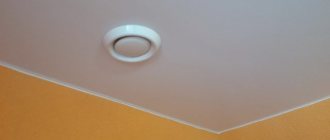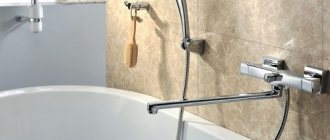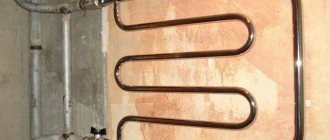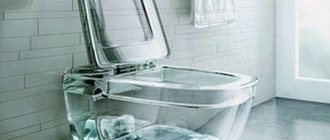Bathrooms designed according to the standard, as well as combined sanitary facilities, do not have a large area. To accommodate all the necessary plumbing and electrical appliances, you have to carefully measure the perimeter of the room and adapt to the few options.
The right solution to this problem is to purchase and install a sink or washbasin above the washing machine. This combination will allow you to intelligently approach the layout of the remaining space. Optimizing the area of the apartment eliminates unnecessary clutter and clutter, which is important from both an aesthetic and functional point of view. Below you will find a complete installation guide with detailed photos and videos, and also read several reviews from similar placement of the sink and washing machine.
Installation sequence
Preparatory activities
At the first stage, a washing machine is installed in the space cleared of unnecessary items and the sink is fitted to the wall.
If it is not possible to install the bowl on the old brackets, then they are dismantled and the places for new fastenings are marked. We remind you that you should maintain a distance of 2–3 cm between the lid of the washing unit and the bottom surface of the sink. If a vertical drain is used, then this gap is measured from the siphon. In addition, if it is necessary to conceal the wiring of utility lines, mark the places where they will be laid. After this, the washing machine is moved to the side, a hole is prepared in the wall for dowel fastenings, channels are grooved if necessary, and pipelines are installed.
Mixer installation
The mixer is installed using the copper fasteners included in the kit. Subsequently, this will allow you to easily dismantle the device for repair or replacement.
If the design of the sink includes a mixer, then it is installed before the product is installed in place. First, connect flexible supply hoses to the valve, making sure that their rubber O-rings are intact. After this, the device is installed in a special hole in the bowl, having previously placed a fluoroplastic gasket under it from the supply kit. Thanks to it, a tight fit of the bottom of the faucet to the sink is ensured, as well as protection of the smooth surface from scratches. On the reverse side, a segment washer is installed on the fastening screw and, using copper nuts from the set, the faucet is securely fixed to the bowl.
Siphon assembly and installation
When assembling the siphon, you should use the manufacturer's instructions
It is important to ensure a reliable fit of all parts of the part and good tightness. It will not be superfluous to lubricate all sealing gaskets with silicone sealant before installation.
After assembly, the siphon is installed on the sink, after which the overflow system is installed, if provided for by the design. The last step is to connect a corrugated hose to the drain system. It is best secured using a threaded clamp.
Instructions for installing and connecting the sink
Dowels are driven into the prepared holes and the brackets supplied are mounted.
It is important not to tighten the fasteners until the washbasin is properly adjusted. Having installed the sink in place, control and, if necessary, adjust its horizontal level. If the longitudinal displacement of the structure is prevented by a special hook, then a corresponding mark is made on the wall. The washbasin is removed and the nuts securing the brackets to the wall are tightened. A layer of sealant is applied to the metal surfaces of the parts to protect the sanitaryware from damage. According to the mark on the wall, a hole is drilled into which an anchor or dowel is installed and a fastening hook is mounted. A layer of silicone sealant is applied where the back surface of the bowl meets the wall. The sink is installed on the prepared brackets
At the same time, it is important to monitor its fixation on the hook. The washbasin drain is connected to the sewer pipe, and the flexible connection is connected to the hot and cold water pipelines.
After checking the functionality of the mixer and the absence of leaks in the drain system, the washing machine is moved closer to the sink and connected to the water supply and sewer pipe. After this, the equipment is installed in place, not forgetting to adjust the horizontal position.
Video: How to install a sink above a washing machine
For practical and safe operation, it is important to ensure that the plumbing and electrical equipment are correctly matched. The factor of aesthetic perception of the structure should not be overlooked.
A wide range of models allows us to provide a holistic, harmonious picture. That is why the design is easy to fit into the interior, resulting in a bathroom that will delight you with its convenience and appearance.
Types of sinks installed above the washing machine
Structure placed at a distance of 6 cm from the washing machine
The main requirement for such a plumbing product is its shallow depth. Together with the drain lip, it should not exceed 20 cm. For the thinnest models, the depth is 8-10 cm. And the length and width should be greater than the dimensions of the washing machine. The inner bottom is flat or slightly concave, with a slight slope towards the drain. Because of their similar shape and large horizontal dimensions, these shells are called “water lilies” or “shells.”
Shape and material of manufacture
Shallow depth is the only parameter that unites water lily shells. Otherwise, the line of manufactured models differs little from conventional washbasins.
Most have a square or rectangular shape. But there are oval and round models. Even rarely used corner sinks are available in a flat version.
There is no less variety in the materials from which they are made: ceramics and sanitary porcelain, metal and glass. For those who, in addition to saving space, are also interested in a stylish appearance, models made of artificial stone are offered. But you can also buy budget acrylic flat sinks.
Drain location
This is an important characteristic for a washbasin mounted above a washing machine. Compatibility with a particular washing machine model largely depends on the location where it is located. And the shape of the drain hole affects the efficiency of the water drain and the frequency of its cleaning.
Depending on the location, drainage in water lily sinks can be:
- Central, like ordinary washstands. The shape is traditionally round. This arrangement is most suitable for reliable water drainage. It will go away completely without stagnating inside the sink. But in this case, the drain siphon will be located above the washing machine. Therefore, the use of a special flat siphon will be a prerequisite. However, its installation increases the height of the sink by 10-12 cm. The disadvantage is also that in case of any leaks at the joints, water will fall onto the body of the machine.
- Rear location. The drain outlet is located at the back of the sink in the center. A siphon is connected to it there. This design allows the use of a conventional siphon, since it will be located close to the wall on which the sink is mounted. But then you won’t be able to push the washing machine against the same wall. A suitable option for such a drain would be to purchase narrow models of washing machines. A big plus is that if the siphon or outlet hoses leak, water will not spill onto the body of the machine. Only accidental contact due to careless washing is possible.
- Lateral location. The drain also comes out of the back of the sink, but is moved to one of the side walls, located almost in one of the corners. There are no advantages compared to the rear central location. Only the original look. This may be why such models are not so common.
With a central drain, installing a siphon above the washing machine body increases the height of the sink. In addition, the distance between the bottom of the washbasin and the top cover of the machine also becomes large, which does not always look elegant. But the rear and side options allow the installation of a sink with a minimum gap between it and the washing appliance. From the outside they look like a single unit.
The shape of the internal drain hole also matters:
- The round hole at the bottom of the sink drains the water completely. But it requires the use of a special siphon.
- A slit cut into the back wall does not guarantee complete drainage and leaves some of the water at the bottom of the sink. In addition, a narrow gap becomes clogged more easily and often has to be cleaned.
Mounting methods
Wall mounting type
The main option is to mount the sink directly to the wall using brackets. The height depends on the size of the washing machine and the type of drain.
An overhead method is also possible, in which the “water lily” crashes into the tabletop and the machine is installed under it. The countertop can only be under the sink, but more often it is combined with an additional cabinet. There are options in which the machine and the sink are spaced apart, rather than located above each other. But at the same time, the main advantage is lost - saving space in the bathroom. This is just a beautiful design for a separate arrangement.
Availability of mixer
Not all lily pad sinks have a hole to accommodate a faucet. Models not designed to accommodate it are considered lightweight and the word “light” is added to their name. This option should be installed in close proximity to the bathroom. In this case, a mixer with a long spout is used - one for the sink and one for the bathroom.
Criterias of choice
If you decide to place the sink above the washing machine, then you cannot limit yourself to just the washbasin. Some machine models are not suitable for installation under a sink. And some versions of “water lilies” require the selection of specific characteristics of the machine.
Dimensions
It is recommended to limit the height of the washing machine to 60 cm. If the thickness of the sink is 15-20 cm, its upper edge will be located at a level of 80-85 cm above the floor. And when choosing a “water lily” with a central drain and a flat siphon, it’s a little higher. This height is acceptable for a person of average height. But the location at a level of 1 meter will cause inconvenience when washing. For children you will have to install stands or benches.
The horizontal dimensions of the structure itself are chosen slightly larger than the dimensions of the washing machine. In the top projection, the machine must be completely covered by the equipment installed above it. Then accidental splashes and drips when using the sink will not fall on the unit placed below.
Water drainage and supply
The choice of a specific drain hole option also depends on the parameters of the washing machine being installed:
- The central drain not only requires the purchase of a special flat siphon, but also increases the final height of the entire structure by 10-15 cm. A leak in the drain line can flood the machine itself.
- Rear or side drains are preferable from a safety point of view and do not require special siphons. But to fully utilize their benefits, such sinks must be installed above shallow washing machines. Considering that the washbasin must completely cover the car, the maximum value of this parameter is 40 cm.
If you intend to install a mixer on a water lily sink, then during the calculations you need to provide additional space between the wall and the machine, where the supply hoses will be located.
Safety
The location of a water source above an electrical unit is potentially dangerous for the machine itself, and sometimes for humans. Minor leaks during use of the washbasin can ruin the appearance of the washing machine, but are unlikely to cause serious damage. But overfilling the bowl and pouring a large amount of water promises big trouble. Therefore, it is necessary to have overflow protection in the design of the sink. You can also install automatic drain control.
As a result, it turns out that in order to achieve maximum comfort when using a flat sink, it needs to be paired with a small-sized washing machine with a limited volume of laundry to be washed. The maximum load of machines combined with “water lilies” is unlikely to be more than 3.5 kg. Attempts to place a standard washing machine under the washbasin will certainly affect the convenience and safety of the entire complex.
Features of the water lily shell
This type of sanitary ware has a number of features that distinguish them from other versions of sinks.
non-standard models, countertop under the bathroom sink
The sizes of these sinks are also very varied; in a small room it is best to install a compact “water lily”, it takes up very little space. For spacious bathrooms, larger sinks are suitable; they are more convenient to use, as they have sufficient depth.
If you decide to install a sink above the washing machine, then it is best to choose one so that it covers its upper part. This will prevent water from getting on the unit, and there will be less splashing when washing.
Water lilies differ in the type of drainage; it can be vertical or horizontal. The second option is used when installed above a washing machine, but it has a number of disadvantages:
- horizontal drain becomes clogged more often;
- water leaves much slower than in a vertical one;
- A siphon for such a drain most often has to be purchased separately, and it cannot be found in every plumbing store.
A standard vertical drain is more convenient, but it cannot be installed above the washing machine, as water may get into the power supply wires, causing a short circuit.
Water lily sinks are often produced without a hole for the faucet, so it must be either wall-mounted or shared with the bathtub. In some cases, this is a very convenient option, but if it is not possible to equip such a faucet, then you need to look for sink models with a special hole for its installation.
If you have the opportunity to purchase a deep sink, then you should give preference to it, since such models are much more practical. They eliminate constant splashing on neighboring objects and are more convenient to use.
Water lily shells can be made of various materials:
- ceramic (faience);
- vinyl (plastic);
- polymer concrete sinks (made of cast marble).
The latest version of plumbing products has been produced not so long ago; they have their advantages compared to other sinks:
- you can choose from a large number of colors;
- sinks made of cast marble weigh much less than those made of natural or artificial material;
- they have higher strength and wear resistance;
- the price of such “water lily” shells is comparable to their counterparts made from other materials that are more common at the moment.
pros
- The main advantage of a water lily sink is that with its help you can free up space in the bathroom that would be occupied by a washing machine. The space thus freed can be used to install other plumbing equipment or furniture, for example, a bidet, a small shower cubicle or a cabinet for toiletries.
- The sink above the washing machine still looks quite original. If you choose equipment that is harmoniously combined in color and style, then such a design will be perceived, first of all, as an unusual design solution, and not as a necessary measure to save space.
- The choice of water lily shells is very diverse. They differ in functionality, shape, size and materials of production. Therefore, you can definitely find the sink that fits perfectly into your bathroom.
Features of water lily shells
Water lily sink with washing machine
A special feature of the water lily shell is its shape: flat bottom and low height. Such dimensions leave a lot of free space under the sink. You can install a washing machine, a tank for dirty laundry or a cabinet for bath accessories.
The design height does not exceed 25 cm. In some models it is 17, 20 cm. The drain hole is located in the far part of the bowl. The siphon has an unusual shape, pressed against the sink.
Advantages of water lily wash basins:
- a plumbing fixture allows you to save space by placing a washing machine and sink in the same area;
- the unusual shape of the sink makes the interior unique;
- The variety of shapes and sizes allows you to find the desired version of the water lily and fit it harmoniously into the interior.
Disadvantages of shallow washing:
- a non-standard siphon is used for sewerage; purchasing difficulties may arise;
- a completely filled space under the washbasin causes inconvenience when taking water procedures;
- when used in conjunction with a washing machine, the sink is installed higher than usual, which is inconvenient;
- not all models of washing machines are suitable for use with a water lily;
- difficulties with installation, take measures to prevent splashes from getting on the electrical wiring during operation.
Depending on the design, the following designs of water lilies are distinguished:
- By the drain. It is placed horizontally or vertically. The second option is practical in terms of hydraulic parameters.
- According to the form. Square, rectangular, oval and semi-oval designs are used.
- By water supply. A hole for the mixer can be made. If it is missing, the water supply tap is mounted on the wall. The mixer can be used together with the bathtub.
Choosing a place
As a rule, there is a single sewer system between the bathroom and the toilet. Changing the location of the pipeline in an apartment is quite difficult, but possible.
When choosing a place for the sink, you need to take into account its size and the dimensions of the washing machine. You should also evaluate the possibility of moving equipment around the premises in case repair work is necessary. The installation process should also not be complicated by limited space.
You should not place the design of a washing machine with a compact water lily in the kitchen. Washing dishes in a flat sink is inconvenient.
What types of sinks are there for installation above the machine?
Not every sink is suitable for combination with a machine. Classic models are too bulky, given their size and unsuitable drainage device. The best option for mounting on top of a washing machine is a water lily sink with a side drain. Its low height and flat shape make it stand out among standard models. The drain of “water lilies” is located near the back of the bowl, closer to the wall, and their depth usually does not exceed 20 cm.
Water lily shells are made from a variety of materials. Sink made of polymer concrete is characterized by increased resistance to chemicals and mechanical stress. The acrylic sink attracts users with its smooth surface and impact resistance. “Water lilies” made of ceramics, plastic, glass and metal are no less in demand. Products can be of different shapes - square or rectangular, with rounded or even corners, as well as original configurations.
Sinks for installation above the washing machine are available in a wide range of shapes and sizes
First of all, you should choose a sink based on technical parameters. It is advisable that the width and length of the sink be at least 10 cm larger than the unit. This way, the electrical appliance will be protected from water getting into, for example, an unprotected control panel. Between the wall and the appliances it is necessary to leave space for hoses and pipes, which should also be taken into account when choosing a sink.
To install a sink above a narrow washing machine with a depth of no more than 37-39 cm, it is recommended to buy a sink with a width of about 50 cm. If you plan to place a unit with a depth of 50 cm under the sink, the optimal solution would be a bowl with a width of at least 60-62 cm. The following are considered the most popular models: “Quatro” (60 x 60 cm), “Uni” (60 x 50 cm), Tehnolit Kompakt (50 x 50 cm).
Another criterion for choosing a sink for installation on a washing machine is the type of drain. It is convenient when the hole is located in the back wall of the bowl or as close to it as possible, for example, in the corner under the soap dish. There are drains of different configurations:
- Round shape. The drain contains a flat siphon located directly below the drain hole, making the system less susceptible to stagnation of water and blockages. The big disadvantage is that if there is a leak, the liquid gets onto the body of the electrical equipment, which can cause a wiring malfunction or a short circuit.
- Slit-shaped. The siphon is located behind the unit, which significantly reduces the risk of water getting into the electronics, but the drain system can often become clogged due to the narrow drain hole.
For installation above a household appliance, you can choose other washbasin options, for example, a built-in or overhead bowl. These miniature and practical sink models are suitable for installation either inside or on top of any horizontal surface. A tabletop, cabinet or table is suitable for installation. To place a built-in model in them, you need to cut a hole where most of the sink will hide. An overlay bowl matched to the style can be an excellent interior decoration.
Sink and washing machine under one countertop create a single ensembleThere are also ready-made furniture sets for a washing machine with a sink, for example, “Lotos 120”. With the help of a set or a common tabletop, you can achieve the integrity of the interior, but you are unlikely to be able to save space.
Minuses
- Those who already own a water lily sink note the inconvenience associated with the inability to come close to the washbasin. For many, this causes quite a lot of discomfort when performing daily hygiene procedures.
- If the user manages to get close enough to the sink, it may happen that he accidentally touches the controls of the washing machine with his feet or stomach. If the unit is turned off, then nothing bad will happen. But pressing buttons on a running washing machine can cause unpleasant consequences.
- If the dimensions of the sink and washing machine are not selected correctly, then there is a danger of water splashing on the “washing machine” and on the electrical outlet, which can lead to serious problems.
- Not every washing machine can be installed under a lily pad sink. Only small-sized models, which are not produced by all manufacturers, are suitable for this purpose.
- For a water lily sink you need a special flat siphon. If one does not come with the washbasin, then you will have to purchase it yourself, and the search may take some time. In addition, the horizontal drain requires increased attention, since blockages quite often form in it.
This is interesting: Piping in the bathroom - advice from the experts
Installing a sink above an electrical appliance
The equipment installation technology is quite simple and includes three main stages. Let's look at each of them in detail.
Secure the bowl
To attach the water lily sink to the wall, use the brackets that come with it. The master only needs to fix them at the desired height and hang the bowl.
Let's get started:
- We mark the wall. We draw a line corresponding to the top panel of the washing machine. We will make the remaining marks relative to this line. We try on the bowl, not forgetting to leave a gap between the sink and the washing machine. Its size depends on the type of siphon. We mark holes for fasteners. If the bowl is located close to the bathtub and a common faucet is supposed to be installed, check whether its spout is long enough.
- We drill holes. We use anchor bolts or dowel fastenings as fasteners.
- We install the brackets. Do not tighten the bolts completely yet, leaving small 5 mm gaps.
- Apply silicone sealant to the back of the sink. Apply the composition in a strip at a distance of 5-10 mm from the edge of the bowl. We carry out a similar procedure with the protrusions of the brackets, where they come into contact with the surface of the sink.
- We install the bowl on the brackets. To do this, we put the sink lugs on metal hooks and fix it to the wall with dowels or anchors.
- Fully tighten the bolts securing the brackets.
The drain of the “water lily” sink is located as close as possible to the back wall of the bowl
Installing a siphon
It is recommended to attach the siphon to the sink before the brackets are tightened. We install the device in this order:
- We assemble the unit, guided by the diagram that the manufacturer necessarily includes in the packaging with the product. Do not forget to thoroughly lubricate all sealing elements and threaded connections with silicone grease. We tighten the thread very carefully, otherwise the plastic parts may not withstand the force and break.
- We find a pipe at the siphon for connecting the washing machine and put a drain hose on it. The resulting connection must be secured with a clamp with a screw tightening. This way we can be sure that the pressure of water drained from the washing machine tank will not break the hose.
- We connect the siphon outlet to the sewer. Craftsmen advise additionally bending the outlet of the corrugated pipe into an elbow and securing it with insulating tape or soft wire. This is necessary to prevent the possible appearance of an unpleasant odor from the sewer, since in the flat siphons with which “water lilies” are equipped, due to their design features, the water seal very often breaks.
The flat siphon for the sink is equipped with a special pipe for connecting the drain hose from the washing machine
Installing the mixer
The design features of a flat sink suggest the absence of a mixer. The best option for such devices is a mixer mounted on the wall.
The most commonly used model is with a long spout, common for bathtub and washbasin. In some cases, a hole is provided in the body of the “water lily” for installing a mixer.
It is installed in strict accordance with the manufacturer’s instructions after the installation of the siphon is completed and the bowl is finally secured to the brackets.
When installing the mixer, do not forget about careful sealing. Be sure to lubricate all seals with silicone grease.
We seal the threaded connections with plumbing tow with paste or fum tape. Tighten the nuts on the mixer hoses very carefully. They are made of fairly brittle zinc alloys; excessive force can simply destroy them.
After installation is complete, we conduct a test run and carefully inspect all connections for possible leaks.
If the “water lily” is equipped with a hole for the mixer, it is installed in strict compliance with all instructions from the manufacturer
A bathroom sink installed above a washing machine is a practical solution that helps save money and effectively organize free space.
It is very easy to implement it in your home. You need to choose the right electrical appliance and plumbing equipment; the easiest way would be to purchase a special kit. They are offered by many manufacturing companies. You can install such a tandem yourself.
During installation, it is important to remember the need to ensure electrical safety and perform all work carefully, following all the requirements of the instructions.
How to install a mixer?
The mixer is sold complete with some models. There are sinks for which you need to buy this part yourself. Plumbing experts advise choosing a faucet that can be fixed to the wall. It has a special long spout. The faucet is shared between the bathroom and the sink. Before installation, you should carefully study the instructions.
An important point in this work is maintaining tightness. At the joints it is better to use tow or modern fum tape. If the design contains rubber seals, it is better to treat them with a special lubricant. Do not overtighten the nuts.
Review of manufacturers of washing machines under the sink
Few washing machine manufacturers offer models that can be placed under the sink. You can buy bosch washing machines under the sink, also from manufacturers such as Zanussi, Electrolux, Candy and Eurosoba. Such models have a maximum depth of 51 cm, height of 70 cm and width according to the washbasin parameters.
An example of a Bosch model that is installed under the sink, its main characteristics
Most often, equipment for washing has a higher cost, front loading and the presence of a full set of modes.
A manufacturer from Italy offers Kandy washing machines under the sink. You can buy one of the five models presented. They differ in different spin speeds from 800 to 1100 rpm. Moreover, all models have equal dimensions.
The Candy under-sink washing machine has a tank made of a composite material such as silitek. In addition, the equipment has a timer and electronic control with a choice of different washing modes. This is a budget option designed for washing 3.5 kg of laundry.
Compact Kandy design
Zanussi also presents inexpensive equipment. Models of this brand have identical parameters, but differ in the number of revolutions. The device is equipped with a leakage protection mechanism.
Zanussi unit
Models from the Swedish company Electrolux are also popular. They differ in spin speed. With their help you can wash up to three kilograms of laundry.
You can also choose a model from the Swiss company Eurosoba. Such equipment is known for its excellent build quality, reliability and variety of programs. You can purchase a ready-made set of automatic machine with washbasin. The manufacturer uses only durable stainless steel drum and tank.
Installation option for a modern model
Washing machines are often installed under the messenger sink. This company produces special washbasins for this type of machine.
Prices and characteristics of some models are presented in the table.
| Model/Photo | Characteristics | Prices, rub. |
| Candy Aqua 2D1040 07 |
| 18 500 |
| Candy Aqua 2D1040 07 | ||
| Electrolux EWC 1350 |
| 32 600 |
| Electrolux EWC 1350 | ||
| Zanussi FSC 1020 C |
| 31 600 |
| Zanussi FSC 1020 C | ||
| Eurosoba 600 |
| 29 990 |
| Eurosoba 600 | ||
| Daewoo Electronic DWD-CV701JC |
| 19 000 |
| Daewoo Electronic DWD-CV701JC | ||
| Zanussi FCS825C |
| 25 000 |
| Zanussi FCS825C | ||
| Candy Aquamatic 2D1140-07 |
| 21 000 |
| Candy Aquamatic 2D1140-07 | ||
| Eurosoba 1100 Sprint |
| 45 000 |
| Eurosoba 1100 Sprint |
Review, model Candy Aquamatic 2D1140-07
Review, model Eurosoba 1100 Sprint
Video
We bring to your attention a video that shows the main stages of installing a sink.
About the author:
She graduated from the Institute of Tourism of the Federal Pedagogical University with a degree in Management, loves to travel and communicate with people. She is interested in psychology, enjoys dancing, and studies English. During the five years of maternity leave, I thoroughly mastered housekeeping, not forgetting about my own development. He skillfully uses words and can support a conversation on any topic thanks to his interest in different areas of life.
Found a mistake? Select it and click the buttons:
Ctrl + Enter
Interesting!
There is a washing machine “for bachelors”. Linen washed in such a unit does not need to be ironed at all! The thing is that the device does not have a drum: some things can be placed inside the container directly on hangers (for example, jackets and shirts), and smaller things (for example, underwear and socks) can be placed on special shelves.
Benefits and Features
Installing a washbasin above the washing machine has one obvious and main advantage - saving space. It is especially relevant for small rooms, in which it would otherwise be impossible to place both important elements at once. You can even add a locker. To do this, the sink is moved slightly forward, and while washing, nothing will interfere at knee level.
This installation is one of the most effective ways to use space. But there is a second significant advantage: the variety of sink models and installation methods. There is a suitable option for any interior.
Joint installation is traditionally used in the bathroom. This is not the best option for the kitchen. Compact and flat sinks are convenient for washing, but not for washing dishes or doing housework.
Kitchen placement option
Another common location for installing a washing machine is the kitchen. In this case, in order to save space for other appliances, the question arises of installing the machine and sink under one countertop. This type of installation is called built-in.
This placement of devices looks quite interesting in the interior, since the design of countertops and cabinets can be varied. The advantage of this placement is that it is not necessary to look for a washing machine that is suitable in both size and design. The design of the countertops may contain doors that will close the washing machine when it is not in use, which means it will not be visible at all. And due to the fact that countertops of such designs are made from a wide variety of materials, it can become the highlight of the entire interior, both in the kitchen and in a spacious bathroom.
The most common materials for making countertops are:
- Glass;
- Stone;
- Treated wood.
Having a countertop above the washing machine has significant advantages. You can place jars, hygiene products or other not-so-resistant things on top. During operation, the machine creates vibrations, and the tabletop increases the amount of usable space. This advantage also applies when placing the machine under the countertop in the kitchen. A tabletop is an excellent addition to the interior; it can also help create a more cohesive space by visually connecting interior details into a single whole.











